![]()
![]()
![]()
Use LEFT and RIGHT arrow keys to navigate between flashcards;
Use UP and DOWN arrow keys to flip the card;
H to show hint;
A reads text to speech;
65 Cards in this Set
- Front
- Back
|
Asexual reproduction in unicellular organismism is also called b__________ __________.
|
binary fission.
You might also say mitosis. |
|
|
Examples of asexual reproduction in multicellular organisms would include
|
cuttings in plants, root shoots or runners in plants, cutting up flatworms, buds on hydras or sponges, etc.
|
|
|
The main advantage of sexual reproduction is
|
variation in offspring.
|
|
|
Some advantages of asexual reproduction are
|
faster, less energy, no need to find compatible partner.
|
|
|
The molecule that contains all the information on it that an organism needs to function is
|
DNA (deoxyribonucleic acid)
|
|
|
DNA is packaged into recognizable chunks or segments known as
|
chromosomes.
|
|
|
A specific region of DNA that encodes for an inheritable trait is known as a
|
gene.
|
|
|
All of a species genes taken together make up that species
|
genome.
|
|
|
In it's simplest form, mitosis starts with one cell and ends with
|
two genetically identical daughter cells.
|
|
|
In it's simplest form, meiosis starts with one cell and ends with
|
four genetically reduced daughter cells.
The orginal must be diploid and the result will be haploid cells. |
|
|
The cell cycle has two main stages. They are
|
interphase and cellular division (usually mitosis).
|
|
|
Interphase of a cell can be further broken down into these sub stages
|
Gap 1 (G1), Synthesis (S), and Gap 2 (G2).
Perhaps G0 can be recognized too if a cell does not continue through to division. |
|
|
Some cellular activies that occur during interphase include:
|
cell metabolism, such as protein, lipid, carbohydrate synthesis; cell organelle
synthesis, cellular respiration, growth of the cell, synthesis of new DNA; DNA replication |
|
|
The main activity of the cell during "S" phase is
|
the doubling of it's DNA strands.
|
|
|
A checkpoint in the cell cycle is a point where the cell cycle will
|
stop and wait for key cellular processes to finish before advancing to the next stage in the cycle.
|
|
|
There are _________ main check points in the cell cycle.
|
three
|
|
|
Give an environmental limit to cellular division.
|
One of these:
density-depentent inhibition: high densities stop division. or anchorage dependence: cells must be anchored to a substrate to divide. |
|
|
Cancer cells are regular body cells that now
|
ignore cell cycle check points, and do not exhibit anchorage dependence or density-dependent inhibition.
|
|
|
If cancer cells leave the site of original tumor growth the tumor is called ___________ and this process of spreading is called ____________
|
malignant
metastasis |
|
|
Radiation and chemotherapy work against cancer cells because these treatments target
|
all actively dividing cells.
|
|
|
During "S" phase, each chromosome is replicated and now contains two ________ ___________.
|
sister chromatids.
|
|
|
Sister chromatids are bound together by a
|
centromere or kinetochore.
|
|
|
The stages of mitosis given in order are:
|
Prophase, Metaphase, Anaphase, Telophase, and then Cytokinesis.
|
|
|
Key events that happen in prophase of mitosis are:
|
Nuclear membrane disappears
Chromosomes condense Centrioles move to the poles (animal cell) Spindle apparatus forms |
|
|
Metaphase of mitosis is easy to recognize because
|
the chromosomes line up along the equitorial plate of the cell.
|
|
|
During anaphase of mitosis the sister chromosomes are
|
separated and pulled toward the poles.
|
|
|
Some key events that occur during telophase of mitosis are:
|
Chromosomes become less dense
New nuclear membrane begins to form |
|
|
The cytoplasmic event that immediately follows telophase is known as
|
cytokinesis
|
|
|
The start of cytokinesis in animal cells can be seen by the evidence of a
|
cleavage furrow in the cell membrane
|
|
|
The start of cytokinesis in plant cells can be seen by the evidence of a
|
cell plate begining to form along the equitorial region of the cell.
|
|
|
C
|
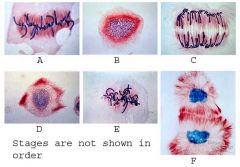
The cell pictured in anaphase of mitosis is labeled
|
|
|
E
|
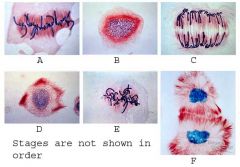
The cell pictured in late prophase of mitosis is labeled
|
|
|
D
|
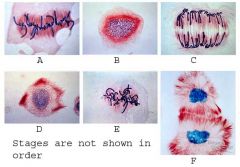
The cell pictured in interphase is labeled
|
|
|
Homologous chromosomes are chromosomes that
|
are the same size, shape, and gene assortment (the the genetic content may vary)
|
|
|
The number of chromosome sets in an organism is known as it's ____________ ________.
|
ploidy count
or "n" number. |
|
|
Cells with two complimentary sets of chromosomes are referred to as
(has homologous pairs) |
diploid or somatic cells.
|
|
|
Cells with only one set of chromosomes are referred to as
(no homologous pairs) |
haploid or gamete cells.
|
|
|
Some key events that occur in prophase I of meiosis are
|
homologous chromosomes pair or synapse to form tetrads
nuclear membrane dissapears chromosomes condense centrioles move to poles (animal cell) |
|
|
In meiosis I ____________ __________ are separated. In meiosis II ____________ __________ are separated, just like in mitosis.
|
homologous chromosomes
sister chromatids |
|
|
Chromosomal reduction (from diploid to haploid) occurs in meiosis ____ (I or II).
|
meiosis I.
|
|
|
List three ways that genetic information is varied through sexual reproduction
|
independent assortment of chromosomes
crossing over during tetrad formation random fertilization (or partners) |
|
|
independent assortment
|
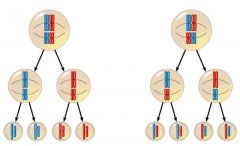
The principal being illustrated in this diagram is
|
|
|
karyotype
|
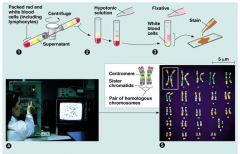
The above picture illustrates the process involved in creating a
|
|
|
The failure of one synaptic pair of chromosomes to separate during anaphase I is known as
|
nondisjunction.
|
|
|
X_ (X0) -- no Y chromosome.
A rare chromosomal disorder of females (1 in 2500) characterized by short stature and the lack of sexual development at puberty. |
Turner's Syndrome.
|
|
|
XXY -- extra X chromosome.
1 in 700 to 1 in 1000 males are born with this condition. About half show lower IQ, slower development. Most are sterile. |
Kleinfelter's syndrome.
|
|
|
Extra copy of chromosome 21.
|
Down syndrome.
|
|
|
DNA is found in the nucleous of most living cells. Give another source of DNA that might be found in a cell.
|
DNA in mitochonria.
DNA in chloroplasts. |
|
|
In an organism's life cycle, what process moves from diploid to haploid, and then from haploid back to diploid?
|
meiosis
fertilization |
|
|
In life cycles that have multicellular organisms in both the diploid and haploid stages, the haploid organism is known as a ______________.
|
gametophyte
|
|
|
In life cycles that have multicellular organisms in both the diploid and haploid stages, the diploid organism is known as a ______________.
|
sporophyte
|
|
|
Many small or single celled organisms will reproduce using _____________ unless conditions become hostile and will then use _____________ .
|
mitosis
meiosis |
|
|
alternation of generations is
|
The alternation of gametophyte and sporophyte stages in the life cycle of a plant.
|
|
|
anaphase is
|
An intermediate stage of nuclear division during which chromosomes or chromatids are pulled to the poles of the spindle.
|
|
|
binary fission is
|
Simple cell division in single-celled organisms.
|
|
|
Cancer can be simply defined as
|
A syndrome that involves the uncontrolled and abnormal division of cells.
|
|
|
The cell cycle is
|
The cycle of cell growth, replication of the genetic material and nuclear and cytoplasmic division.
|
|
|
Cell Division can be simply defined as
|
The process by which two cells are formed from one.
|
|
|
The centriole is
|
A short cylindrical organelle, found in pairs, and responsible for the formation of a spindle apparatus during division in animal cells.
|
|
|
A centromere is
|
the constricted region of a chromosome, to which the spindle fibres attach during division.
|
|
|
A chromatid is
|
One of the two side by side replicas produced by chromosome replication before mitosis or meiosis.
|
|
|
A clone is a
|
An individual formed by some asexual process so that it is genetically identical to its parent.
|
|
|
cytokinesis is
|
The division of the cytoplasm of a cell into two daughter cells.
|
|
|
A cell having two chromosome sets, or an individual having two chromosome sets in each of its cells. Is known as a __________ cell
|
diploid.
|
|
|
An abnormal human phenotype, including mental retardation, due to a trisomy of chromosome 2l is known as
|
Down syndrome.
|

